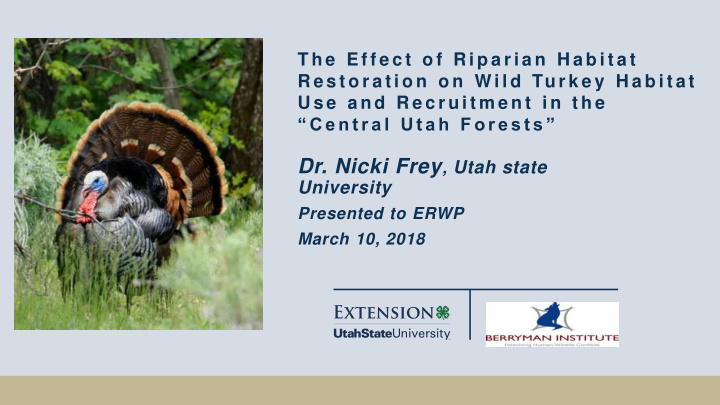



T h e E f f e c t o f R i p a r i a n H a b i t a t R e s t o r a t i o n o n W i l d Tu r k e y H a b i t a t U s e a n d R e c r u i t m e n t i n t h e “ C e n t r a l U t a h F o r e s t s ” Dr. Nicki Frey , Utah state University Presented to ERWP March 10, 2018
Experience
Turkeys Largest Gallinaceous species Toms: 17- 21lbs, 40” Females: 8- 11lbs, 30”
Study Background • Co-existed with native Americans in Utah but extirpated • Translocations began in the 1920s with farm- raised stock; didn’t end well • 1950s wild Merriam’s from CO and AZ into Garfield County (i.e. Escalante) • 1989 began transplanting Rios from Western states into southern Utah • Used successful transplants to build populations throughout Uah • Important and Popular Game species in Utah • $430,000 from permits in 2016
Study Background • Still, statewide there are concerns • high-quality winter habitat • lack of ecology research a • In Utah, Russian olive believed to be the primary food source and shelter • Thus, your restoration project has attracted some attention Wild turkeys in ag field in winter
Ecology Nesting Needs • On the ground • Merriams nest in higher alt woods • Rios in cottonwood galleries • Heavy herbaceous cover, logs • Rios: ¼ mile from water • Rios: Grass 18” • Insects for poults
Ecology Habitat Needs for Merriam’s Merriam Habitat Needs • Gambel’s Oak/Pondo forests for nesting • Juniper, Pinyon, and Gambel’s oak for forage
Ecology Habitat Needs for Rio’s • Layered vegetative cover • Bushes around 4’ tall/wide • Roost trees (cottonwoods) • Prefer open areas under the roost trees • Grass, insects, mast, forbs
Riparian Restoration
Riparian Restoration 2010 2015
Objectives - • Evaluate the general habitat use and movement patterns • Monitor the nesting and recruitment success • Compare the nesting success and vegetation components • Empirical study? • Compare the over-winter survival • Empirical study?
What We can Determine • How often and when turkeys use treated riparian areas • What habitat turkeys prefer in each season • Where the turkeys go • If females nest in different areas, we can compare nesting success among these areas • If turkeys over-winter in different areas, we can compare survival of these turkeys among different areas
What We Can’t Determine • If turkeys use treated riparian areas differently than before • If recruitment is different than before • If turkey movements are different than before • Empirical data from other states to compare to what they do now
Study Design • GPS and VHF Telemetry • Treated and Untreated Drainages? • Winters: Escalante • Summer: Boulder Mtns and GSENM
Objective 1: Habitat Use and Movements • 32 transmitters • Mostly females • GPS and VHF • 3-4 daily locations GPS • Once weekly VHF • Seasonal habitat use? • Movement patterns?
Objective 2: Nesting Success and Recruitment • GPS to identify nesting • VHF visited twice weekly • During incubation • Post-hatch nest analysis • Brood-rearing habitat analysis • What does nesting habitat look like? • What does brood rearing habitat look like? • Do hens use treated areas?
Objectives 3 and 4: Comparisons • Is use different than other areas in US? • Does habitat use correlate to nesting success? • How long after treatment does it take • Breeding and non-breeding females • Toms and jakes
Partners • Utah State University Extension • USFWS Partners for Fish and Wildlife • Utah Division of Wildlife Resources • Bureau of Land Management • Grand Staircase-Escalante National Monument • NWTF-Utah
Started Last Week • Terry Tolbert, BLM • Sue Fearon, ERWP • Clint Wirick, FWS • Me – Nicki – USU Extension Putting on a transmitter
Example of Data
Timeline Activity Months Years Trapping Jan - April 2018, 2019, 2020 Telemetry January 2018 August 2020 Nest-Brood Data May - July 2018 - 2020 Collection Data Analysis and August 2018 October 2020 Reporting Final Report December 2020 Thesis June 2021
Outputs • Increased knowledge of turkeys in general • Increased knowledge of response • Ability to manage so as to support wild turkeys • Fact sheets, thesis, news releases • Youth education
Thanks for Your Interest and Support
Recommend
More recommend